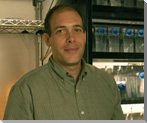 |
 |
Division of Intramural Research
 |
Overview |
 |
Vision, Mission and Values |
 |
Organizational Chart |
 |
Research Branches
|
 |
Research Investigators
Profiles, publications, links |
 |
Clinical Research
Clinical trials, patient recruitment, IRB, FAQ, Overview |
 |
NHGRI Affiliated Centers
CIDR, CRGGH, NCGC, NISC
|
 |
Online Research Resources Developed at NHGRI
Databases, software, tools, more. |
 |
Division of Intramural Research Calendar
Workshops, conferences, seminar series, courses, more. |
 |
Books and Publications |
|
 |
 |
In Other Sections:
|
 |
 |
|
 |

 |
Benjamin Feldman, Ph.D.
Investigator
Medical Genetics Branch
Head
Vertebrate Embryology Section
B.A. University of California at Berkeley, 1985
Ph.D. Columbia University, 1995
|
|
Dr. Feldman uses zebrafish as an animal model for elucidating basic principles of vertebrate embryonic development. His focus is on molecular pathways that are active during gastrulation to orchestrate some of the earliest steps of cellular differentiation. His laboratory disrupts specific genes to identify which ones are essential in the normal differentiation process. As some of these genes are evolutionary cousins to human genes involved in developmental disorders and cancer, and certain disrupted phenotypes in zebrafish are analogous to those seen in human syndromes, these studies provide an opportunity for establishing the underlying cause of related human diseases.
During the developmental process of gastrulation, embryos undergo dramatic changes, morphing from an assembly of indistinguishable cells into an organized, basic body structure comprised of multiple cell types. Aberrations during human gastrulation can cause significant developmental deformities and miscarriage. Studies have shown that several signaling pathways act in concert during gastrulation. Prior to arriving at NHGRI, Dr. Feldman helped determine that defective Nodal signaling causes cyclopia in zebrafish; this model can be used to study holoprosencephaly, the most common defect of the forebrain in humans. Dr. Feldman's research program now involves major collaborations with human geneticists to study human holoprosencephaly-associated mutations in the SIX3 gene and in the Nodal-pathway transcription factor gene FOXH1. Using zebrafish embryos, he and his colleagues have established which mutations in these two genes pose the greatest risk of causing holoprosencephaly.
In separate studies, Dr. Feldman's laboratory is building on his earlier work related to Nodal signaling and its links to cyclopia (See: Zebrafish Nodal Signaling Pathway). Using antisense nucleic acid analogs targeting translation of the zebrafish equivalent of FOXH1, his group has found evidence for an early Nodal-independent role for non-DNA-binding portions of this protein, and is now working to create a zebrafish mutant line to further validate these findings. The group is also exploiting zebrafish squint mutants, which are null for one of three zebrafish Nodal-related ligands, as animal models of a complex genetic disease. Similar to human complex diseases, the phenotypes of squint mutants have variable penetrance and expressivity, often displaying cyclopia and only sometimes displaying a midline closure defect. Genetic and environmental risk factors that affect the incidence of both of these phenotypes in squint mutants have been identified and grouped into those affecting either one or both phenotypes. Dr. Feldman is now developing strategies to identify and classify a broader set of genetic and environmental risk factors underlying these phenotypes.
A major thrust of Dr. Feldman's research efforts focuses on the differentiation of embryonic cells into mesoderm, endoderm, and ectoderm. These cells initially form the three primary germ layers, and later go on to form virtually all adult tissues, such as blood, bones, and muscle (mesoderm), visceral organs (endoderm), and skin and brain (ectoderm). Dr. Feldman's group devised a technique called FACS-Assisted Microdissection of Photolabeled cells (FAM-P) to separate mesoderm and endoderm precursors from ectoderm precursors prior to any visible steps of differentiation. Using this technique, Dr. Feldman's laboratory has explored the global gene expression of early mesodermal, ectodermal, and endodermal cells, identifying hundreds of germ layer-specific genes. These data offer promising avenues for further research.
In particular, Dr. Feldman's group is exploring the function of uncharacterized genes whose expression was found by FAM-P to be enriched in the early mesoderm and endoderm. His initial strategy involves a novel high-throughput time-lapse documentation system  to identify developmental anomalies in zebrafish embryos in which translation of these genes into protein has been blocked via introduction of antisense nucleic acid analogs. This approach has enabled Dr. Feldman's group to pinpoint genes with critical functions. For example, it has led to one project studying a MAP-kinase signaling attenuator (Dusp4) and its role in endoderm differentiation, and another examining a particular transcription factor's role in endoderm migration. Dr. Feldman's laboratory is also utilizing emerging reverse-genetic strategies and other approaches to explore more deeply the functions of these genes. to identify developmental anomalies in zebrafish embryos in which translation of these genes into protein has been blocked via introduction of antisense nucleic acid analogs. This approach has enabled Dr. Feldman's group to pinpoint genes with critical functions. For example, it has led to one project studying a MAP-kinase signaling attenuator (Dusp4) and its role in endoderm differentiation, and another examining a particular transcription factor's role in endoderm migration. Dr. Feldman's laboratory is also utilizing emerging reverse-genetic strategies and other approaches to explore more deeply the functions of these genes.
 To view the time lapse presentation on this page, you will need Flash Player installed. Download the latest version of Flash Player. To view the time lapse presentation on this page, you will need Flash Player installed. Download the latest version of Flash Player.
Last Updated: April 30, 2009
|
 |

|
 |

